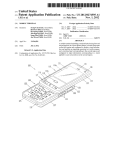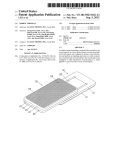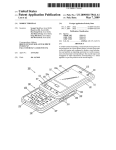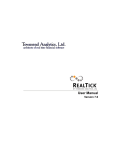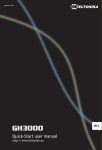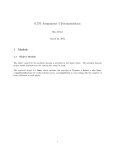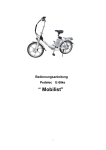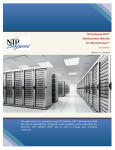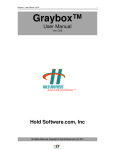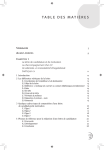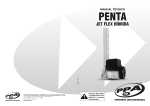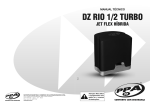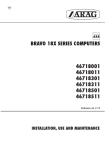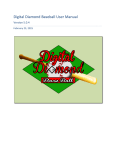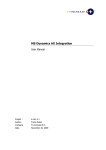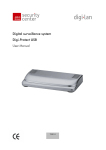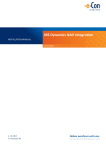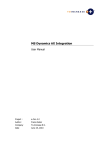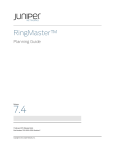Download The Simulation Game
Transcript
Emergent Sustainable Mobility: The Simulation Game The environment as part of every-day (mobility) decision making. Game description and user manual Ton van Asseldonk TVA developments Platform Sustainable Mobility February 2007 Version 1.0 Mobility Simulator Manual 12-02-07 2 Contents 1. Game description ................................................................................................ 3 The game concept .................................................................................................. 3 Gaming strategies................................................................................................... 4 2. User manual ........................................................................................................ 5 Game Control.......................................................................................................... 5 Joining a simulator session as a Player .................................................................11 3. Emergent Sustainable Mobility Concept.............................................................19 Sustainability and mobility......................................................................................19 Emergence as system concept ..............................................................................19 DME’s: transactioning sustainability......................................................................21 In vitro-testing: from idea to reality .........................................................................25 Simulator scope .....................................................................................................26 4. Application Installation........................................................................................29 System requirements..........................................................................................29 Installation instructions .......................................................................................29 5. Client system requirements ................................................................................35 Mobility Simulator Manual 12-02-07 3 1. Game description The game concept This is a game. It may be a serious game, but it’s still a game. The purpose of the game is, in competition with others, to maximise the benefit of your mobility choices in terms of a combination of comfort and economy. The player who achieves the highest combined score on these two axis wins the game. Before the game starts you define a travelling profile, deciding for which type of travel (based on distance, weather and luggage conditions) you will use which type of transport: car, public transportation, taxi or bike/foot. Based on this profile the journeys generated by the program will be “taxed” in the form of “DME’s” (Duurzame Mobiliteits Eenheden), which are based on the CO2 consumption of the respective travel modality choice. Every month you will get a new supply of these DME’s, but in the course of time this monthly allocation will become smaller and smaller, forcing you to become more and more economical with the use of these DME’s. There are two ways to reduce you DME utilisation: • • By changing your travelling profile you can use more environmentally friendly modalities. Yet choosing the bike for travelling in bad weather with heavy luggage will reduce your DME use, but also dramatically reduce your comfort score. So clever choices in your profile will optimize your DME usage versus your travelling comfort. You can adjust your profile at any point in time as you like. You can change your car to a less polluting one. Dependent on the game settings, this however can cost you a penalty. If you are using less than the allocated amount of DME’s, you can trade these DME’s with other players. If they have been careless, they need to buy DME’s (otherwise they are forced to walk, destroying their comfort score, and minimizing their chances to win the game). Dependent on the behaviour of these other players the price of these DME’s on the market can and will vary. By trading cleverly you can convert your excess DME’s into money. By buying cheap and selling expensive you might even make handsome profits on the trading itself. In any case, your total score is determined by the multiplication of your money score and your comfort score. Be aware: at the end of the game (or at the end of every year; dependent on the game settings) remaining DME’s have no value; you need to convert them either in money (by selling them) of in comfort (by using them). For a more comprehensive description of the game and the underlying principles of emergent behaviour please refer to section 3 of this manual. Mobility Simulator Manual 12-02-07 4 Gaming strategies Successful strategies will be dependent on other players behaviour, and hence there is no general rule how to win the game. However there are a few guidelines which might help you to get going: • • • • In the beginning of the game, there tends to be plenty of DME’s. As a consequence they are cheap, and you can boost your comfort score at a relatively low cost. On the overall score screen you can see the performance of all players. If they go for comfort they will need DME’s in due course. Making sure you have them for sale might be a good strategy. The other way around, if they go for money, they will want to sell, and you can buy them cheap, boosting your comfort score. If you want to reduce your DME consumption, then choose the reduction in a planned way. In comfort terms it’s less costly to do sunny short trips on a bike than long wet journeys. The weight factors in calculating the comfort score can be seen under the tab “GameStats” in your userscreen. Other players can see your money- and comfortscores, but they cannot see your stock of DME’s. So keeping more or less of your excess DME’s from the market for a while might put them on the wrong foot and create an advantage position for you at some point in time. In any case, the game is about balancing your modality decisions and your trading decisions, and do so in relation with the other players behaviour. You can on the one hand reduce the DME use, but in general that will reduce your comfort score as well. By doing this cleverly however the money value you generate by selling the excess DME’s might well outweigh the cost in comfortscore. Mobility Simulator Manual 12-02-07 5 2. User manual In this section we will describe the user interface and give a step by step approach on how to join a simulator session. First we will describe how to setup a simulator session as a game controller. Game Control When you browse to the domain where the mobility simulator is located, the first page you see will contain the fields as shown below. The gamecontroller can login by entering the following data in the lower login box: UserName: admin Password: mobilitypass After having filled in the credentials and clicked on the ‘Login’ button, you will be taken to a new screen which is shown below Here you can enter a name for the session that you want to create. After entering a name, the ‘Open Session’ will be enabled and can be clicked. When doing so new sections will become visible on the screen (see next page). Mobility Simulator Manual 12-02-07 First we need to configure the settings for our session in the orange marked box. After having set all necessary fields, click the next button at the bottom of the box to continue. 6 Mobility Simulator Manual 12-02-07 7 The content of the orange marked box will then change into the following: Here you can change the residence and job location for the player template that the users will be using when playing the game. The job function determines the yearly KMs a player will travel when playing the game. The distribution pattern of these KMs are shown in the lower part of the box. After having clicked the ‘Next’ button again, the content will again change into the following: Here you will be able to start, pause and resume (when paused) the game. Moreover, you will be able to set the game speed at which the game will be played. The maximum speed is 500 milliseconds per day, less milliseconds per day is not allowed. Before we can start the game, users will need to be logged in and ready to play the game. By ‘ready’ we mean that they have created an account and set their preferred travelling pattern. On the following pages, we will show some more screens that will explain the rest of the game control interface. We use tabulators as partManual of our Mobility Simulator navigation. We are currently in the Control tab. The other tabs are only needed once the game has begun. 12-02-07 These lines show the users that are logged in. The ‘Is Ready’ status indicates if they are ready with setting up their profile and waiting for the game to start. In this box the game controller is able to send messages to individual users, or all users at once. This box will show all the messages that the users have send to the game controller. 8 Mobility Simulator Currently,Manual the Scores tab is 12-02-07 9 activated and so the screen content is changed. This chart shows the user scores for all users in session. This box shows various information about the session in progress. This list shows the comfort scores, money balance and DME balance for each user. This box shows all the actual DMEs on sale. This chart shows the price evolution for sold DMEs. Mobility Simulator Manual Currently, the Users tab is 12-02-07 10 activated and so the screen content is changed. When selecting a user from this dropdown list, the boxes and charts below will show user specific information. This chart shows the monthly DME usage and predictions for the chosen user. Some textual user information This chart shows a historical overview of the money balance of the user. This is the travelpattern as setup by the user himself. When the user changes his pattern, it will be shown here as well. Mobility Simulator Manual 12-02-07 11 Joining a simulator session as a Player In the simulator there are two possibilities to login. First, there is the situation where you want to join a new session and you need to create a new player account for yourself. Second, there is the situation where you were already connected to a session, but due to circumstances you lost connection and need to reconnect to the same session as before. We will first explore the steps that need to be taken when joining a new session. When browsing in Internet Explorer to the main page of the mobility simulator, you should see the following screen: On the screen you see two (blue) dialog boxes in which user information can be entered. Since we want to create a new player account for ourselves, we will use the blue dialog box at the top. Here we will need to think up a username for ourselves and a personal password. The password needs to be entered twice in order to prevent typing errors. After having filled in the three textboxes in the top dialog box, we can press the ‘Create’ button to continue the process. After having clicked the ‘Create’ button, a new screen should appear which holds the elements as shown in the first figure below. Depending on the situation, the dropdown box will either show active sessions (first figure) or a message that no sessions are currently active (second figure). When no sessions are active, the game controller is most likely still setting up a new simulation session, or no simulation was planned at that time. The session list will refresh automatically, so when new sessions become available you will notice this right away. When there are sessions available, you will be able to select them from the dropdown box and click on the ‘Next’ button. Mobility Simulator Manual 12-02-07 12 After having clicked on the ‘Next’ button, the following screen will appear, here you can choose a car for the session: Choose the sorting order for the car list Choose your preferred car This screenpart will show car specific information As soon as you have made a decision about which car you want to drive, you can click the ‘Next’ button. After which the following screen element will appear: Three travel distances: 0-7,5 km, 7,5-50 km and 50+ km Two luggage types: light luggage and Three weather conditions: sun, rain and snow In this element the user can adjust his travelling preferences towards various combinations of travelling conditions. By clicking on one of the eighteen fields (currently showing an image of a car), the user can change the modality for that combination of travelling circumstances. In the two figures shown on the next page, we want to change the preferred travel modality for the situation where the sun is shining, we only have light luggage to carry and when travelling less than 7,5 KMs. When we click on the car image in the upper left corner for the specified scenario, a new window appears right beneath the car image, in which we can select our preferred modality. When we click on the image of the walking person, the image in the upper left corner will change into the image of a walking person. In this way we can specify travelling modalities for specific scenarios. Mobility Simulator Manual 12-02-07 13 We can also specify travelling modalities for more than one scenario at once; for example for a specific weather type, a specific luggage type, or a specific range of kms. We can do that by clicking on the weather images, luggage images or km range texts. In the figures below we change the modality for all situations where it is snowy, in this case we have chosen the train (public transport). When you feel that your modality pattern fulfils your needs, you can click on the ‘Next’ button underneath the pattern table. You will then enter the main screen where all the game play will take place. The Figures on the next pages will show the various gameplay and informational elements that are used during the game. Mobility Simulator Manual 12-02-07 14 We use six tabs for our navigation; when clicking one, the screen will change its content (yellow marked box) Here you can adjust your travel pattern. This chart will show information on DME usage and stock levels The upper part of the map will show user information and game status information The upper left part will show trip specific data, i.e. luggage, weather, distance and modality specifics This chart will show information about your on money balance and balance averages. This part shows the car that is currently being driven This chart will show your user score and those of others. Here you can buy, sell or adjust the price of DMEs. Mobility Simulator Manual When selecting the market tab, a chart will be shown with DME transaction information. I.e. price maximums, minimums and averages. 12-02-07 15 Mobility Simulator Manual 12-02-07 16 When selecting the New car tab, you will be able to select a new car and exchange it with your old car. Note that when changing more often than allowed by gamecontrol you’ll be charged a penalty (10% of book value) Mobility Simulator Manual 12-02-07 When selecting the Messages tab, you are able to read messages sent by gamecontrol, but also send messages to gamecontrol yourself. Note: When a new message is received your Messages tab will start flashing! 17 Mobility Simulator Manual 12-02-07 18 The gamestats tab shows session information, DME usage per KM for various modalities and the weight factors for the comfortscore formula. Moreover, the userscore list with DME and money balances is shown as well. Mobility Simulator Manual 12-02-07 19 3. Emergent Sustainable Mobility Concept Sustainability and mobility Each of us takes a lot of decisions on mobility. Not just once a week, but many of us every day, or even more times a day. Yet for most of us the impact of our mobility choices on the environment is not very prominent in these decision processes. While we are generally aware of the macro-impact of mobility on the quality of our environment, the prominence of this aspect in our routine decision making is low. The isolated impact of each decision is low, the daily options to make an important contribution are small, and the balance between personal convenience and environmental considerations readily tilts towards the convenience aspect. Sustainability is largely associated with new fuel and engine technology, improved public transportation, improving motorway-flow, etc. And all (or most) of these are considered to be outside our individual hands. On the other hand governments are wrestling with the macro consequences of this behaviour. Kyoto compliance, health risks, etc increasingly cause the need for policies that effectively reduce the level of emissions gradually towards a sustainable level. Many of the available solutions and technology could contribute to this aim, but require critical mass to become viable. And enforced reduction of mobility volume threats the perspective of economic growth, employment and prosperity. Seen from a systems point of view, none of the actors, although good-willing and aware of the macro-problem, seem to be capable of moving towards higher levels of sustainability at a pace that does justice to the recognized sense of urgency of this problem. It’s like a prisoner’s dilemma: although each and every one of us recognizes the need, our respective behaviour as an actor in the system doesn’t do a great deal to achieve this aim. Emergence as system concept Above description of system behaviour is not just true for the mobility related issues in our society. It represents a general class of problems we are facing in the highly individualized modern societies. Whereas we might expect governments to take decisions for the good of us all, and implement and enforce these decisions by means of law or regulations, this mechanism proves increasingly ineffective in producing the aspired effects. There are a number of reasons underlying this shortfall: • Whereas in the past our needs and aspirations might have been sufficiently similar to be captured in a limited set of regulations, the increasing heterogeneity and individualization in today’s society severely complicates regulation and legislation. On top of that most regulation cannot any longer be isolated from an international context that limits the freedom of action of any Mobility Simulator Manual • • 12-02-07 20 particular country. The resulting complexity makes it difficult to agree, communicate and enforce such regulation. The growing competences and information available at the actor level increases the occurrences of escapes from such regulation, reducing the intended benefits, and sometimes leading to social injustice and in-equality. Hence reducing the acceptance of the regulation and complicating enforcement. Due to the above, lead times to establish regulation get longer, and the regulatory process is unable to keep up with the pace of external change. In many cases the result is “too little, too late”. All of this applies also to the environmental impact of out mobility behaviour. To say it bluntly: while we have “outsourced “ the environmental issues to our governments, these governments face a growing impossibility to turn these issues timely into regulatory frameworks that recognize societal diversity, and secure a sufficient level of acceptance at the actor level to be effective in yielding new behaviour. Metaphorically, the system works as a crossroad with traffic lights, while the traffic becomes increasingly complex and the drivers are increasingly unlikely to obey the light signals. Using the same metaphor, there is an alternative in the form of a roundabout. While serving the same function, the working mechanism of a roundabout is markedly different from the traffic-light controlled cross-road. Not planning and top-down control, but a “clever” interaction rule (“left-priority”) hands the decision-making to the users of the roundabout. Pursuing well-understood self-interest (clearing the roundabout) and a clever geometric design permitting continuous (be it slowed down) movement, produce a much more acceptable solution to the problem with a performance (in terms of throughput and adaptation to changing traffic conditions) that is far superior to any traffic light solution. In the roundabout example one could say that the “macro-behaviour” of the system “emerges” from the micro decisions taken by the users. Such systems are called “emergent systems”. This is in contrast to the cross-road example where the macrobehaviour is a direct result of the green-red signals instructing the drivers. This “roundabout principle” has a general applicability. The principle is very well known form biology. Flocking birds and ant-nest organisation are examples. Many societal processes are using this very principle. Our market economy itself has many examples, but also recent initiatives as “Persoonsgebonden Budgetten” in the AWBZ care. It is increasingly applied in logistical processes, in self-organizing units within companies, etc. Although the mechanisms to make it generally work are not yet fully understood, there is a growing belief that the application of principles of emergence to complex organisation problems might provide a solution for the problems described above. Mobility Simulator Manual 12-02-07 21 The core design elements of such system are: • • • The actor self-interest (roundabout: “keep moving”) Some “directional” mechanism, directing actor energy in meaningful behaviour at system level (roundabout: “left-priority rule”). Some form of governance, conditioning actor interactions within the “bandwidth” of the system (roundabout: liability when violating the priority rule). In the following paragraph we will apply these principles to the issue of mobility related emission. DME’s: transactioning sustainability Emergent sustainable mobility requires the active involvement of the mobilists themselves. Not choosing a car, but turning the ignition key starts pollution, so in the end it’s the mobilist behaviour that counts. Almost all relevant decisions are taken at the mobilist level: • • • • The travelling decision Travelling is a way of establishing societal connectivity. Mobilists themselves decide between physical displacement and other ways of connecting to others, e.g. through telecommunications. Sometimes (e.g. delivering goods) there is no substitute, sometimes (e.g. working from home using telecommunications) there is. The modality decision When travelling, the choice between the various modalities (car, public transportation, bake, walk, etc) is very much in the hand of the individual mobilist. Not just in private travel, but also in business travel. The timing decision With current heavy traffic conditions the timing of the travel has important impact on the environmental impact of the chosen modality. The car decision Even with company cars, the mobilist generally has a wide range of choices, not just in brands and types, but also with respect to fuel source and environmental impact quality. Although in business related travel, company policies might provide some restrictions to above decisions, it is in general very much left to the individual to weigh the different aspects and make the decisions. Yet, especially in business travel, most of the consequences of these decisions, measured in time, money or otherwise, are absorbed by the employing company. Both in business and in private travel, the financial and the time impact seem to bear little weight in the mobilist decision making process. Part of the problem is the limited marginal effects of every-day mobility choices, and the inertia of established habits. Mobility Simulator Manual 12-02-07 22 As a consequence, environmental impact is not a regular part of mobility decision making. It is relegated to government and employer regulation to take those aspects into account by means of fiscal policy and corporate lease arrangements. Just like in our roundabout example, transferring the environmental dimension of mobility decisions to the level of the actors (mobilists) is the key to turn the system into an emergent system. By requiring them to take the environmental impact of each and every of the four mentioned mobility-decisions into account, these aspects become part of everyday-life. So we start by carving up the environmental space[1] available[2] over the mobilist population. Each of them receives an equivalent part[3] of this space, expressed in “Duurzame Mobiliteits Eenheden”(DME). To secure smooth working of the system, it is likely that this allocation will be made available in monthly slices with a 12 month expiration date attached to them. Subsequently, all mobility will be dually priced: the economic price (as is currently the case) reflects the economic costs of the chosen modality, as well as a DME price. This DME price is equal to the environmental space used by the actual journey and the chosen modality. This DME price would be part of fuel prices, of public transportation tickets, taxi payments, etc. [4] This system is illustrated in the figure below. DME system concept [1] The definition could cover any aspect of environmental impact or combinations of such impact. For the purpose of this document we will use CO2 emission as an example [2] This could e.g. be the space available as per the Kyoto protocol, or the mobility related compartment of it. [3] For a nation wide implementation this equivalent would be the total annual environmental space divided by, say, the number of adults in the country. For the pilot implementation the actual use of environmental space used by each individual could be used as a starting point. [4] Providers of these will be (this is an aspect of the governance required around the system) not be allowed to sell fuel or provide transportation without the DME’s being paid. Under their licence to operate they will be obliged to return the DME’s collected to the governing body in the amount they consumed environmental space to provide this transportation or fuel. Mobility Simulator Manual 12-02-07 23 We are already very familiar with such dual pricing mechanisms, be they used for different purposes, in the form of “Air miles”, “Shell stamps”, “Rocks”, and may other incentive schemes that are around. The difference is that the DME system will be used for “paying the environmental price” rather than receiving benefits for client loyalty. It is important to note that the existence of this DME payment as a separate dimension is key to the working of the emergent system. If we were to embed the DME price in the economic price, the awareness of the environment as a recognizable dimension in mobility-decisions would vanish. The recognition of this psychological effect in the mentioned incentive schemes is (part of) the secret of their success. In addition, as especially in business travel all the financial costs are born by the employer, the personal meaning of the mobility decisions would be taken away[5]. The DME payment system hence creates a separate, individualized, space for decision making at the mobilist level, detached from the financial consequences of the mobility decision. In this way the environment becomes part of each and every mobility decision. Obviously, by making these choices, the individual mobilist will experience shortage or abundance of DME’s. Under conditions of overall shrinking space (steered by the governing body) there will be continuous shortage at the system level, but at the level of the individual mobilists, conscious mobilist will end up with unused DME’s while careless mobilists might experience severe shortage. By making these unbalances in DME’s tradable, clever users create advantages that can be exchanged for money. With a high price when the overall shortage is severe, and a low price when the overall use of DME’s declines with the availability at system level. The DME trading price hence reflects the “system state” in terms of matching reality and goal, and will increase incentives when these are out of balance. Yet, the choice remains to be individual, and each and every individual mobilist can aim for his/her own balance in mobility choices between convenience and environment. By clever decision making in each and every mobility decision, considerable benefits can be achieved. In this sense, it is not a system of restriction and punishment, but a system of opportunity and reward. As a consequence, the well understood self-interests of the mobilists will pressurize the suppliers of mobility solutions to deliver better propositions in terms of utility versus DME price: better lease-propositions, environmentally better cars and fuels, better public transport propositions, etc. These suppliers can be considered as a second process-layer, above the layer of mobilists, and providing the “solution space” available to these mobilists[6]. Not, as currently, forced by regulation, but by the mass of mobilists looking for advantageous mobility solutions, responding becomes an existential need. Every mobilist, therefore, has the freedom to create new and innovative solutions to improve their competitive position. [5] This is markedly different from other “pricing” initiatives as road pricing. Unlike some popular believes, emergent systems require hierarchy. Yet it is not a “command and control” hierarchy but a hierarchy of process layers, stacked in a very precise way. [6] Mobility Simulator Manual 12-02-07 24 Even a third layer of system actors can be identified: the car manufactures, energy suppliers, transportation technology suppliers, infrastructure suppliers, etc. They provide the tools for the mobility solutions suppliers in the second process layer, and will in turn be pressured by their client to come up with better propositions. In this way the energy released at the mobilist level will work itself upwards through the system to change the behaviour of all actors, and orient their energy towards better solutions and propositions in a “natural way”. Complying becomes a matter of survival in the markets in which they operate. It reflects the fact that emergent systems are more about organising energy than about organizing specific solutions. These solutions “emerge” in the “solution space” of the system. This system of process layers is illustrated below. Where does the government fit? In emergent systems the government is not a system-agent[7]. In the same way as an arbiter in a sports game is not a player, the governing body of an emergent system is not an actor. It doesn’t prescribe the actor behaviour, but guards the “rules of the game” and sets some overall system parameters. It is e.g. similar to the role of the national banks in the financial arena: it secures compliance of the players and sets the “base interest rate” to steer the “health of the system” and to keep it within its operating bandwidth. If it were to compete with the players, the governing role would be terminal. Governance (“game-rules”/boundaries) Players Time constant Of Change years Capabilities conditions Means months conditions Days/hours Expansion-pressure Expansion-pressure Modality DME system process layers [7] in its governing role, governments may also part wise be suppliers of e.g. infrastructure •infrastructure • car manuf’rs • Technology • energy suppliers • car sales • railway cys •‘public transport cy’s • lease cy’s/fleet owners • employers • tank stations • drivers Mobility Simulator Manual 12-02-07 25 In vitro-testing: from idea to reality Robert May, one of the pioneers in this area, wrote already in 1965: “Even simple interactive dynamic systems do not necessarily have simple behavioural properties” The problem in understanding the system behaviour of emergent systems is that this behaviour is not simply the aggregate of isolated individual behaviour. The individual actors influence each other, both within a specific process layer, as well as between process layers. In our DME system mobilists will learn how to use the system to their advantage by looking at others, solution suppliers will adopt from and adapt to the initiatives of their competitors, mobilists will be influenced by new propositions, etc. In system design terms: an emergent system is a complex dynamic interaction of positive- and negative feed back loops, and its behaviour is highly non-linear. And the fact that it is non-linear makes it impossible to understand the whole by understanding the parts. Simple design errors might cause the system not to work. The “right priority”-rule most of Europe has used for roundabouts up till the 1980’s for example doesn’t work. It was only when we changed this that roundabouts became the preferred solution in many situations. This is unlike the working example that existed in the UK. It took us a long time to draw this lesson and change the priority rule. If we were not to know roundabouts, it is highly unlikely that the users would invent by themselves that a left-turn means driving 270 degrees around. And “motorway zipping” does work in Germany, but not in Holland, however much energy we put in promotion and communication. All of these are examples of failing emergence in an interactive system, without a clear relation between cause (at the actor level) and effect (at the system level). Emerging order is hence not for free. The natural alternative for the order arising from “planning and control” is chaos and failure. Effective emergent systems require careful design of process hierarchy, interaction mechanisms and governance aspects. One of the most powerful ways for designing emergent system is simulation. Is such simulation the real actors (in our case mobilists and solution providers) interact with each other in a virtual space in which the DME system is built. They are requested to take the decisions (at the mobilist level the four decisions mentioned earlier, at the solution provider level the introduction of new propositions) at accelerated speeds (“plays a week/month in a minute”). This accelerated speed enables fast analysis of longer term system behaviour, but also forces the players into “rapid decision making” reflecting their “natural behaviour”. By looking to “what they do”, rather than “what they say they will do” it provides a much more reliable base for system design than other design methods. By experimenting with the system design parameters and mechanisms, the system can be optimized prior to real life introduction, and solutions providers can make a first pass at new propositions that might differentiate them in their competitive Mobility Simulator Manual 12-02-07 26 position. It accelerates organisational learning and dramatically reduces the chance of failure of the system. Participating in the simulation also helps to understand the DME system and learn to use it cleverly to own advantage. In summary a simulation for the DME system will provide the tool for: • • • • • Proof of concept for the DME Testing and tuning design and mechanisms: o Accelerated “what-if” testing of system aspects o Complex dynamics and Stability o Governance principles Communication to participants Behavioural research (mobilists) Propositions testing (suppliers) Simulator scope Based on above rationale a plan was made to develop such simulation tool. With this tool the actors (mobilists, solution providers and traders) essentially play a game in which 3 spaces interact: • • • The modality choice space The solution space The DME space Repetitive mobility requests are put forward to mobilists who then, according to personal need combined with DME consequences, make a choice from the available solutions. One or more traders can participate as market makers(see figure below). Traders/ Marketmakers PAEA Space Mobility requirements Mobilist Available solutions Solution providers Mobility Simulator Manual 12-02-07 27 As indicated, each mobilist receives continuous mobility requests, to which he needs to respond by making a choice from the available modalities. These modalities include the car (and fuel type) he has chosen, available public transportation (dependent on local availability). With the request relevant situational information will be given with respect to weather conditions, luggage and purpose of journey. This purpose will be linked to his/her professional activity. mobilist graphical interface (design concept) The interface is built to enable fast decision-making, by presenting all relevant information graphically and only requiring the click of a mouse button to choose from the available options. The system will the calculate DME consumption and adjust the balance of his/her DME account accordingly (see figure above). The DME account is fed regularly with the monthly allocation. The mobilist can choose at any time to buy/sell DME’s to other participants, and the result will be recorded in the € account. Solution/means suppliers can introduce new propositions from which the mobilists can make a choice. Such solutions could be new car types, new fuel sources, new public transport options, etc., each with their specific characteristic in DME requirements. At the end of the lease period (or other moments as specified by the lease proposition) the mobilist can order a new car. The system will offer a wide range of cars, and give relevant user information for the choice. This information will include DME performance in quantitative terms, but also in the form of the ECO-label which is currently under development as part of the Sustainable Mobility project. Mobility Simulator Manual 12-02-07 28 The simulator sequence is illustrated in the figure below. simulator sequence The tool is essentially a software program, running on a Windows 2000/XP platform, and interfacing with a central controller through LAN/Internet connections. The technical structure is shown in the figure below. Technical structure of the simulator Mobility Simulator Manual 12-02-07 29 4. Application Installation System requirements In order to let the mobility simulator work properly, the following software be installed on the server: • SQL Server 2005 • IIS Server • ASP.NET 2.0 (v2.0.50727) • .Net Framework 2.0 Installation instructions On the CD two directories can be found that are of importance for this installation: 1. ‘MobilitySimulator V1.0’ 2. ‘SQL Files’ In directory nr. 1 the ASP.NET files are located, in directory nr. 2 the SQL Server files are located. First lets setup the asp.net application. 1. Copy the directory ‘MobilitySimulator V1.0’ somewhere on the local harddrive of the server. 2. On the windows server machine open the application server window and browse to the website folder. Then create a new website or open an existing one and select the option ‘new Æ virtual directory’. Mobility Simulator Manual 12-02-07 30 3. Follow the directions of the wizard and when asked, refer to the ASP.NETasp.net directory that you just copied to your local harddrive. Next we need to set-up the SQL Server database: 1. Copy the directory ‘SQL Files’ somewhere on the local harddrive, and rename the directory when necessary. 2. Open MS SQL Server Management Studio and login on SQL Server with administrator permissions. 3. Right click on the database folder in the Object Explorer tab and choose the option ‘Attach’. 4. Click on the add button in the next window and look up the sql server files that you just copied on your harddrive, then click the OK button. Mobility Simulator Manual 12-02-07 31 5. You should now see database items appear in the window: 6. After clicking next, the database should appear in the object explorer in the folder ‘Databases’. 7. Next we need to make sure that the ‘ASPNET’ user1 has permission to execute stored procedures that are located in the database. 8. Browse to the Security folder under the SQL Server instance (root folder) and right click on the ‘<ServerName>\ASPNET’ user, next choose ‘properties’. Here <ServerName> will show the computer name of the server on which ASP.NET is installed. 9. In the left-hand list choose ‘User mapping’, then check the marker box of the mobility database in the right-hand window (see picture below). Next, mark all the checboxes in the role membership area as shown in the picture below. Finally, click the OK button. 1 This user is created automatically when the administrator installed ASP.NET software on the server, you do not have to create one manually. Mobility Simulator Manual 12-02-07 10. Now browse to the database in the object explorer and open the folder ‘Security\Users’. You will see that the ‘<ServerName>\ASPNET’ user has been added to the user folder of the database. 11. Right click on the ASPNET user and select properties: 32 Mobility Simulator Manual 12-02-07 33 12. Choose the ‘Securables’ page in the left navigation pane and then click on the ‘Add’ button in the right part of the window. 13. In the next window choose the option ‘All Objects of the types…’ and click OK. 14. In the next window mark the checkbox of the ‘Stored procedures’ item and click the OK button. The window will close and we will be returned to the first window. 15. Here we can see that the ‘securables’ list has been filled with stored procedures; when we scroll a bit down we will see a number of stored procedures which’ names start with the prefix ‘usp_’. One by one go through these stored procedures and check the boxes in the lower part of the window as shown below: 16. After having set the permission on all stored procedures with the ‘usp_’ prefix, click the OK button to save the changes. The database should now be configured properly. 17. The last step to make is to adjust the connection string of the database in the web.config file of the ASP.NET application. Open the web.config file located in the ASP.NET directory in Notepad and look for the ‘<ConnectionStrings>’ tag. Mobility Simulator Manual 12-02-07 34 18. Replace the ‘.’ Located behind the ‘datasource’ variable and change it to: ‘<ServerName>\<SQLServerInstance>’ Here <ServerName> should be replaced by the actual computername of the server, and <SQLServerInstance> to the SQL Server instance name. 19. The Mobility Simulator should now be ready for use on the website as chosen during the setup. When surfing to the website in Internet Explorer, you should be seeing the following: Mobility Simulator Manual 12-02-07 5. Client system requirements In order for the mobility simulator to perform correctly, the following system requirements should be met: • • • • Internet Explorer version 6 installed Adobe Flash Player version 9 installed Access to the internet through a broadband internet connection A minimal screen resolution of 1024x768 pixels 35




































